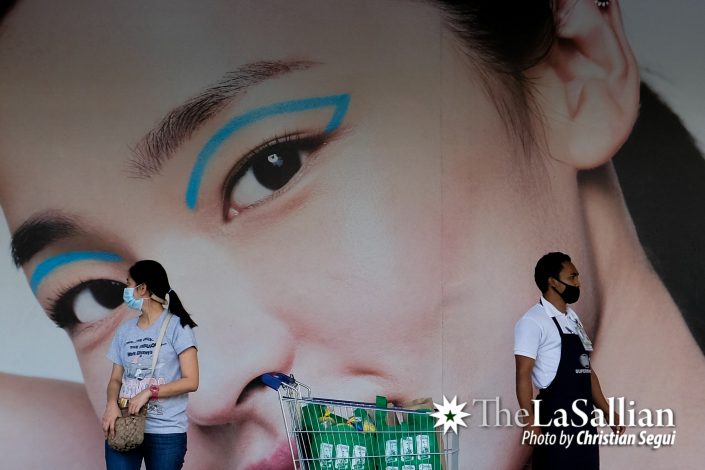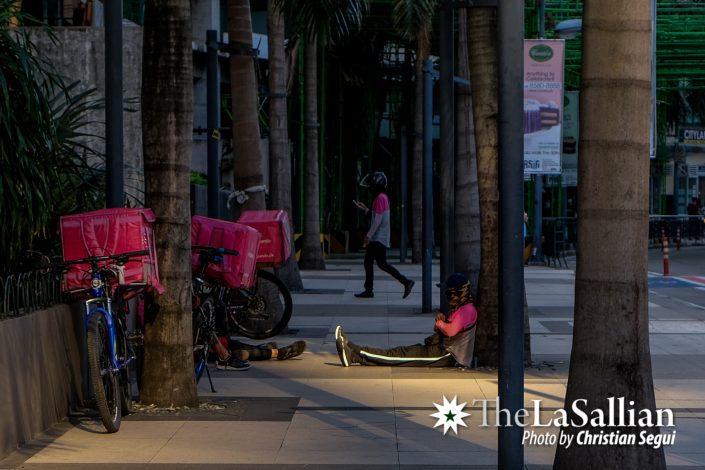The roads are deserted—an unusual sight at this time of the year. Only a few take to the streets as if it were any other day, running an errand to a nearby store as early as 6 am. With half their faces covered in face masks, none of them can take a single, full breath of fresh summer air. As days go by, the COVID-19 pandemic takes its continued toll on Filipinos. Its presence has been cause for countless casualties while testing the country’s determined response to adversity. Aside from the threat posed by the disease, many complications have also arisen despite the sustained efforts to mitigate the crisis.
Government policies under constant scrutiny, the economy in need of stimulation, and people struggling for basic necessities are some of the significant effects of COVID-19. Strict quarantine measures have also jeopardized job security. Given no other realistic choice, many businesses deemed non-essential had to close their doors during this period—not just on their customers, but also on the people whose livelihoods depend on them.
Being without a steady means of income has meant the inability to provide for their families—such is the reality of workers like Joey Lusanta and Rolando Sanpedro. Even as quarantines have gradually been eased, stability remains elusive; and despite persistent efforts to find their footing in these difficult circumstances, these laborers are left with uncertainty about where to go from here.
In isolation
“Parang may giyera sa atin ngayon. Kada kanto may pulis na sisita para hanapan ka ng quarantine pass,” shares Lusanta, a 58-year-old safety officer and warehouseman from a construction company. He adds that even taking a trip to a store is difficult with the risk of being apprehended by the police if you forget to carry a quarantine pass. The long lines you will have to endure once you get there adds to the stress even more, increasing the risk of infection the longer you stay exposed.
(It’s as if we’re in a warzone. At every street corner, there’s a police officer who’d check for your quarantine pass.)
The uncertainty of how—or when—this nightmare will come to an end fills Lusanta with dread as each day empties into another. “Noong unang araw ng Enhanced Community Quarantine ay may pangamba at takot sa aking isipan,” he expresses.
(During the first few days of the Enhanced Community Quarantine, my mind was filled with fear and worries.)
In the midst of a crisis
Sanpedro, a 47-year-old safety officer and warehouseman who works in the same construction company, personally finds the measures, as much as people have the capacity to follow them, to be instrumental in preventing the worsening of the pandemic. “Ako ay sumusunod [sa protocols] katulad ng pagdala ng quarantine pass, ID, at pagsuot lagi ng mask po. At ito ay malaking tulong para hindi lumaganap pa ang sakit ng [COVID-19],” he explains.
(I follow quarantine protocols such as bringing my quarantine pass, ID, and wearing a mask, which I think are a big help to stave off the spread of COVID-19.)
A larger cause for worry comes in a different form: food and other home supplies cannot easily be replenished these days, especially when financial resources run dry or when outside exposure poses a health risk.
For Sanpedro, this is the grim reality. Being the “haligi ng tahanan” or head of the household grows even more difficult, as he admits, “Mahirap mag-adjust simula nung nagkaroon ng [COVID-19]. At nagmahal na rin ang mga bilihin.” His family could only afford to have two meals a day, even having to forego milk for his baby on some days.
(It’s been hard to adjust ever since the COVID-19 outbreak began. Necessities have also become more expensive.)

Nowhere to turn
Akin to roadblocks at every side, facing both health and livelihood issues make for a treacherous conundrum, endangering the survival of individuals and families.
One time, Sanpedro’s children had fallen ill to a different disease. Like many others within his community, he had elected to nurse his children at home. With the growing number of COVID-19 cases, visits to the hospital become laced with the fear of potential exposure to the virus. “Sa panahong ito, napakahirap magpa-doctor. Akala nila may [COVID-19] ka na,” Sanpedro shares that medical staff exercise extreme caution when evaluating any case.
(Nowadays, it is hard to visit a doctor. They would assume you have COVID-19.)
Local government units have been trying to provide relief goods for every family within their jurisdiction. Lusanta adds that the company he works for has given him support as well. However, no matter the rationing, the aid always falls short.
In some cases, they have no other choice but to seek help from others and hope that it gets them through the day. “Kung maubusan naman ay nangungutang o nanghihiram ako sa aking kapatid o nanay,” Sanpedro discloses.
(If finances run out, I have to borrow money from my sibling or mother.)
Though Sanpedro remains hopeful, he also feels frustration over the unmet promises of the government. “Ang inaasahan ko na tulong ay yung manggaling sa DOLE (Department of Labor and Employment) at DSWD (Department of Social Welfare and Development). Kaya lang may nabalitaan ako na ang pinakamahirap lamang ang mabibigyan,” he explains.
(I’m hoping to receive help from DOLE and DSWD. Although, I heard they only give to those desperately in need.)

In the wake of a pandemic
As the immediate shock of the quarantine turns into more of the same disquiet—checkpoints, physical distancing, and hygienic precautions—Lusanta believes the day will come when the situation will return to how it was before. “Ang itsura ng ating komunidad unti–unti na din nababalik sa normal,” he says.
(The community is slowly returning to normal.)
Even as Filipinos are still facing the threat of hunger and the hardships of the quarantine, they remain hopeful. “Sa akin, habang may buhay, may pag–asa,” shares Sanpedro.
(As long as there is life, there is hope.)
Similarly, Lusanta puts the safety of his family and countrymen in his prayers. “[Sumasaatin ang] Diyos,” he says. “Hindi naman po liko ang Diyos para sa taong sa kaniya ay tumatawag. [Kaya’t] huwag matakot sa banta ng [COVID-19].”
(God is with us. He would not forsake those who call upon Him, so we shouldn’t fear the threat of [COVID-19].)
Peering beneath the narrative of resilience and faith, however, lies a much stronger testimony of inadequacy and disservice to the people. In the coming months after the quarantine is lifted and life assumes degrees of normalcy, the threat of the virus will linger in the air, especially for society’s more vulnerable workforce.
As various industries reopen, workers like Lusanta and Sanpedro will do their part in the arduous task of rebuilding the country. The lives of the working class are just as vital, as deserving of dignity as anyone else in this economy; the question now becomes whether society will extend to them the recognition, support, and protection they need.
Sanpedro awaits the end of this crisis, hoping that the “new normal” moves toward a future shaped by change that instead works in their favor. “Harapin natin nang taos-puso sa ating sarili kung ano man ang susunod pagkatapos ng [COVID-19],” he emphasizes.
(Let us wholeheartedly face whatever may await us after [COVID-19].)
